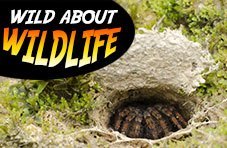While admiring the representatives of rich South African wildlife flying high in the air or roaming the grounds, you might be unaware there’s also tons of activity taking place right below your feet.
Some animals spend all or most of their lives underground, well protected from predator s and extreme temperatures. The soil is also their source of food, providing plenty of delicious roots, worms and insects. Other amazing creatures hide from our eyes in caves, venturing out in search of nourishment, or keep their distance as living close to the surface makes them an easy target to step on. Lower your eyes occasionally when walking around; there are hundreds and thousands of wondrous life forms sharing our lovely home. And in their own way, they are lovely as well.
Crafty Silk Weavers
When thinking of spiders, most of us will shrink away (because they’re “not nice to look at”) and even fear a fatal bite. But the fact is that many of these little creatures are completely harmless. And beauty, as they say, is in the eye of the beholder.
Trap Door Spider is chocolate-brown in colour, with tiny hairs covering its body and legs. They dig burrows in the ground, meant for protection and a place to raise their young, and line them with silk. How is that for a luxurious home? Adult spiders leave their comfy shelter during humid weather to search for a mate, and having mated, the male dies (sorry guys!). Eggs are kept in a cocoon until little spiders hatch and go on their way. Wolf Spider lives in shallow burrows and hospitably keeps the entrance open at all times. Mum carries egg sacs around with her, attached under the abdomen, and when spiderlings hatch, they’ll climb onto her back and live there for the next few weeks. Button Spider is also known as widow spider, as the female often kills the male after mating. This type prefers quiet and dark places so it’s unlikely you’ll ever see them in your house. Their funnel-shaped webs are usually constructed in bushes, close to the ground.
Little Cave Inhabitants
Bats are an important component of South African biodiversity; they either keep the insect population under control (insectivorous species), or take an important role in pollination and seed dispersal of many plants (frugivorous species), such as Baobab which is only pollinated by fruit bats. There are 56 recorded species in this country, out of which dozens are listed as threatened and several as critically endangered or vulnerable. Myths and faulty beliefs often prevent us from seeing these cave inhabitants for what they really are: clean little animals which help farmers get rid of the crop pests, and propagate rain forest trees by taking fallen seeds far from the parent tree. They will not get caught in your hair, nor do they suck blood. And guess what? It’s not that the bats are not blind, at night they can in fact see much better than people!
What’s Hiding Deep Underground?
A relatively recent study has discovered 17 animal species in couple of South African gold mines, living as deep as 1.4 km underground. A variety of warms, rotifers and a copepod (tiny shrimp relative) were found inhabiting the water trapped in rocks. What makes this amazing is that we’re talking about an environment featuring unbearable heat and very little oxygen, which is why the scientists have long believed it couldn’t support any form of life above the single-celled organisms. Before this discovery has taken place, only one complex organism was ever found living so deep - a worm nicknamed the “worm from hell”. If you want to learn a bit more about it, stay tuned as this little thing is special enough for us to dedicated it an article of its own.




